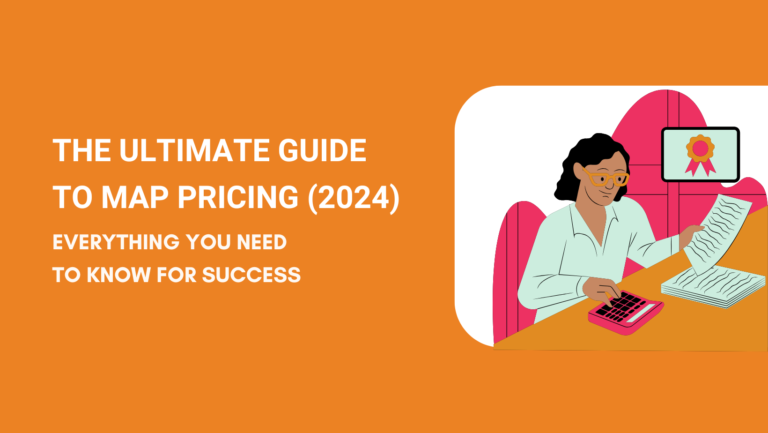Are you struggling to maintain fair competition and protect your brand value in the cutthroat world of eCommerce? The secret weapon you’re missing might just be MAP pricing.
Minimum Advertised Price (MAP) is not just another industry buzzword – it’s a game-changing strategy that’s revolutionizing how brands and retailers interact in the digital marketplace. But what exactly is MAP pricing, and why should you care?
In this article, you’ll learn what MAP pricing is, how it differs from MSRP, and how both can be used to your advantage. You’ll also discover the benefits and challenges of MAP pricing, along with practical advice on how to set and enforce MAP policies effectively.
Whether you’re a brand owner, retailer, or eCommerce enthusiast, understanding MAP pricing is no longer optional – it’s essential for survival in today’s hyper-competitive online landscape.
Let’s dive in!
Key Takeaways
- MAP pricing maintains consistent advertised prices.
- Key differences exist between MAP and MSRP, but they can be strategically used together for optimal sales performance.
- Effective MAP enforcement can protect brand value.
What Is MAP Pricing?

MAP pricing, or Minimum Advertised Price, is the lowest price a retailer can publicly display for a product, set by the manufacturer.
This policy is designed to prevent price wars that can erode brand value. It helps maintain a consistent market price and ensures fair competition among retailers.
A MAP pricing policy specifies the minimum price in advertisements, not necessarily the final sale price. Retailers can still offer lower prices in-store or through private communications.
Benefits of MAP Pricing
- Maintains Brand Integrity
- Ensures Fair Competition
- Protects Profit Margins
Want to know more about the pros and cons of MAP pricing? Keep reading! We’ll walk you through detailed explanations and real world examples in the next sections.
Examples of MAP Enforcement
- Three-Strike Policies: After three violations, a retailer may lose authorization to sell the product.
- Monitoring Tools: Brands use specialized software to track advertised prices across various platforms.
Some well-known companies implementing MAP policies include:
- Apple: Enforces strict MAP policies to maintain premium brand perception.
- Sony: Utilizes MAP to ensure consistent pricing for its electronics across retailers.
Pros and Cons of MAP Pricing
Using Minimum Advertised Price (MAP) policies offers several advantages and disadvantages for brands and retailers. Below, we explore the benefits and challenges associated with implementing MAP pricing.
Pros of MAP Pricing
Brand’s Superiority
You may have noticed that branded products always have higher prices than non-branded products. That’s because the brand has to set a superior image in the customer’s minds.
That’s the main concept behind a private label business. So, the MAP makes use of the customers’ psyche to stay superior and desirable.
You will understand it better if you think as a customer.
Suppose you see two ads for similar products. One from a brand and the other one from a general retailer. If the price of a branded product is lower than the price of a non-branded one, you may not have a good image of that brand.
That’s why brands never want to promote their products at a price that harms their superiority.
Securing the Right Customer Base

MAP helps brands attract their target audience. Advertising below MAP might attract price-conscious customers who may not be interested in other, higher-priced products from the brand.
A luxury car brand like BMW uses MAP to ensure they’re attracting customers who value premium products.
Preventing Price Wars
MAP pricing helps avoid destructive price wars among retailers. When everyone advertises at the same minimum price, no one is compelled to undercut others to attract customers.
This is particularly beneficial for brands like Samsung or LG in the competitive electronics market.
Ensuring Fair Competition
Enforcing consistent minimum prices across all sales channels ensures a level playing field for both large and small retailers. Smaller retailers don’t get priced out of the market by bigger competitors.
A small bookstore can offer the same advertised price on a bestseller as Amazon, for instance.
Increasing Retailer Margins
Retailers often see better profit margins with MAP policies since prices cannot be dropped below a certain level. This provides a stable revenue stream.
This is especially important for brands with complex products, like high-end audio equipment, where retailer expertise is crucial.
Enhancing Authenticity Perception

MAP pricing can help prevent suspicions of counterfeit products. If a customer sees a high-end product advertised at an unusually low price, they might assume it’s fake.
Think of noticing an advertisement offering Nike’s joggers at $20. Even if the seller is offering the genuine Nike joggers at $20, you would most probably consider it as a fake or counterfeit product.
Establishing Product Value
MAP is essential when launching new products. Once a price is set, it’s challenging to increase it later.
For example, when Sony launches a new PlayStation console, they carefully set the MAP to position it correctly in the market.
Facilitating Cross-Selling
Brands often have multiple product lines. MAP pricing helps attract customers interested in a particular price range, making it easier to cross-sell other products.
For instance, a customer buying a Bose speaker at MAP price might be more likely to consider other Bose products in the future.
Consistent Customer Experience

Customers benefit from a consistent pricing experience across different stores and online platforms. This uniformity can lead to increased trust and loyalty to your brand.
For example, a customer seeing the same advertised price for a North Face jacket at REI, Dick’s Sporting Goods, and the brand’s website feels more confident in their purchase.
Cons of MAP Pricing
Challenges in Enforcement
Keeping all retailers in line can be a full-time job. Some might try to skirt the rules with bundle deals or “call for price” tactics.
For example, an electronics retailer might bundle a TV with a “free” soundbar to effectively lower the price.
Resistance from Retailers
Some retailers, especially larger ones used to setting their own prices, might push back against MAP restrictions. A major department store chain, for instance, might resist limitations on their seasonal sales events.
Legal Issues

Implementing MAP policies must be done carefully to avoid violating antitrust laws. Missteps can lead to legal battles and significant penalties.
Limiting Promotions
Retailers might struggle to run their usual sales events.For example, a furniture store accustomed to running “50% off” promotions might find it challenging to create compelling offers within MAP guidelines.
How Is MAP Pricing Calculated?
Calculating MAP pricing involves several factors to balance profitability and competitiveness.
Factors to Consider:
- Production Costs: Start by calculating the cost to produce and ship the product.
- Competitive Analysis: Look at competitor pricing to ensure your product remains attractive.
- Market Positioning: Evaluate how you want your product to be perceived—premium, mid-range, or entry-level.
- Distributor Profits: Ensure retailers have sufficient profit margins to actively promote your product.
- Brand Value: Consider your brand positioning; premium brands may require higher MAP.
- Product Lifecycle: New and mature products may need different pricing strategies.
Example Calculation:
- Production Costs: Suppose it costs $20 to produce and ship.
- Desired Profit Margin: Let’s set it at 50%.
- Average Retailer Margin: 30%.
To determine the minimum advertised price (MAP):
MAP = Production Cost / (1 – Desired Profit Margin – Retailer Margin)
For our example:
MAP = $20 / (1 – 0.50 – 0.30) = $20 / 0.20 = $100
This means the product should not be advertised below $100.
Balancing Profitability and Competitiveness:
You must consider market trends and customer expectations. For instance, if competing products are priced at $110, your MAP can be slightly lower to attract customers without sacrificing too much profit.
In some cases, you might adjust short-term profit goals for long-term competitiveness. For example, setting a relatively low MAP to quickly gain market share.
Flexibility and Legal Considerations:
- MAP policies should have some flexibility to adapt to market changes. Consider allowing limited price adjustments during specific periods (e.g., holidays).
- When developing MAP policies, be sure to consider legal regulations in different regions to ensure the policy is both legal and enforceable.
By carefully weighing these factors, brands can develop MAP strategies that protect profits while maintaining market competitiveness. Regular review and adjustment of MAP is key to ensuring its continued effectiveness.
How Does Minimum Advertised Price Work?

The process of MAP is simple. The brand decides a minimum price at which the retailers are allowed to promote their products. This sets the clear price expectation about a product in the minds of the audience.
The actual sale price may go down in some cases but many people will not see it.
The brand sets its image and the retailers are ensured to earn predefined margins. This process eventually keeps the business running or growing.
MAP vs MSRP: What’s the Difference?
MAP (Minimum Advertised Price) and MSRP (Manufacturer’s Suggested Retail Price) are two distinct pricing strategies used by manufacturers to guide how their products are sold.
MAP is the lowest price that retailers can advertise a product for. This policy helps maintain brand value by preventing price erosion in the market.
Manufacturers often enforce MAP policies to ensure that retailers do not undercut each other by advertising prices that are too low.
Conversely, MSRP is the price that the manufacturer recommends retailers sell a product for. Unlike MAP, MSRP is not enforceable. It’s simply a guideline to help standardize pricing across different resale channels.
| Feature | MAP | MSRP |
| Full Form | Minimum Advertised Price | Manufacturer’s Suggested Retail Price |
| Enforceability | Enforceable by the manufacturer | Non-enforceable, just a recommendation |
| Purpose | Control advertised pricing | Standardize and suggest retail selling price |
| Impact on Retailers | Limits how low prices can be advertised | Provides a benchmark for pricing |
| Example | A camera advertised for no lower than $499 | A camera recommended to be sold at $549 |
Retailers must comply with MAP policies or they may lose the right to sell the product. MSPR serves as a strategic guide but does not restrict retailers from setting their own sales prices.
How Do MAP Pricing and MSRP Work Together?
Although MAP pricing and MSRP are different, they are largely aimed at similar objectives – protecting the profit margins and the image of a brand and its retailers.
A retailer can take help from both pricing strategies in the following ways.
- He can match the MAP and MSRP pricing to synchronize his advertisements and the retail prices.
- As brands give the idea of the lower limit of their products via MAP and the upper limit via MSRP, you get the room to play with pricing in between both.
- In case a retailer wants to run a special promotion on a certain product, he can take help from both pricing and announce a special sale keeping the prices within the acceptable and suggested limits.
How to Set MAP Pricing?

As MAP pricing is mainly about protecting a certain profit margin and setting a standard price of a product, brands usually set the MAP higher than the wholesale price.
The MAP pricing is also above the cost of the product as a brand cannot afford to allow its retailers to sell below the cost.
One of the best strategies to set the MAP pricing is to set the price a little higher than the average sale value of the product.
As the MAP is not meant to be fixed at all times, brands may change the MAP from time to time. They may analyze the sales trends and decide on a minimum price at which the product can be advertised.
How to Enforce MAP Pricing
Effectively enforcing MAP pricing is crucial for maintaining your brand’s value. There are several strategies you can use to ensure compliance.
1. Monitor Advertised Prices
Consistent monitoring is essential to catch MAP violations. You can use third-party services or automated tools that scan online prices across different platforms. These tools can provide real-time alerts when prices fall below the minimum advertised price.
Ensure all your retail partners are aware of your MAP policy. Provide clear guidelines and expectations. Communication is key. Authorized retailers should understand the consequences of violating the policy.
3. Implement Penalties for Non-Compliance
Establish a clear penalty structure. A common practice is the three-strike enforcement policy.
On the first violation, issue a warning. A second violation might lead to temporary suspension. A third strike can result in a permanent ban from selling your products.
This approach has been effective for many brands.
4. Use Technology
Advanced software can track and report MAP violations. Tools like PriceSpider and MAPP Trap can automate this process, making it easier and more efficient to manage.
5. Third-Party Monitoring Services
Utilize third-party services for enforcement. These services can offer comprehensive monitoring, enforcement audits, and even litigation support. They ensure that MAP violations are addressed promptly and effectively.
Here’s an example of an effective MAP enforcement:
Apple is known for its strict MAP enforcement. The company uses automated monitoring tools and has a clear penalty structure for non-compliance.
This ensures that all retailers adhere to the minimum advertised price, helping Apple maintain its brand value and integrity.
Frequently Asked Questions
MAP pricing involves several crucial areas, such as its legal standing, its application within retail, conditions related to selling below the MAP, and the link between MAP and MSRP. Below, we dissect each of these points for better clarity.
Is Minimum Advertised Price Legal?
Yes, minimum advertised price (MAP) policies are legal in many jurisdictions, including the United States.
These policies help manufacturers suggest prices to retailers for advertised products. However, MAP policies must be carefully crafted to avoid violating antitrust laws.
Brands can legally implement MAP policies by clearly documenting their terms and ensuring that all resellers agree to them. It’s essential to work with legal experts to ensure compliance and avoid potential pitfalls related to market competition.
What Is MAP Pricing in Retail?
MAP pricing refers to the minimum price at which a retailer can advertise a product. Although retailers are free to sell the product at any price, they must adhere to the minimum advertised price when publicizing it.
This strategy helps maintain brand value and fair competition among resellers. It also prevents price wars that could damage the brand’s reputation. Retailers benefit from MAP policies by maintaining profit margins and ensuring a level playing field.
Can You Sell Below MAP Pricing?
Selling below MAP pricing can lead to several consequences. Retailers who do so may face penalties from the brand, including the termination of their reseller agreement.
Brands often monitor compliance and may cease supplying products to non-compliant retailers.
However, certain situations, such as clearance sales or promotional discounts, may lead to selling below MAP. Brands usually address these instances through exemptions specified in the MAP policy.
Can MAP and MSRP be the Same?
MAP and MSRP can technically be set at the same level, but this approach has its implications.
MSRP (Manufacturer’s Suggested Retail Price) represents the price that the manufacturer recommends for sale to consumers, while MAP is the minimum price at which the product can be advertised.
Aligning MAP with MSRP simplifies pricing strategies, but it also limits retailer flexibility. Brands need to weigh the pros and cons of such alignment to maintain effective pricing strategies.
Final Thoughts: Understanding What MAP Pricing Means for Your Business
We’ve just shown you how to get around MAP pricing. Policies and strategies are always made for long-term businesses. These are the backbone of a business and are essential for a brand’s survival.
MAP is also a great strategy that not only protects the interests of a brand but is also beneficial for the registered sellers.
Being a brand retailer is like two-way traffic. If you protect a brand’s larger interests by following its policies and guidelines, like MAP, the brand will also protect your interests by considering you a long-term business partner.
Do you require branded items from the best available manufacturers at the most affordable costs? Ask for a free quote and one of our experts at NicheSources will guide you through every step.

